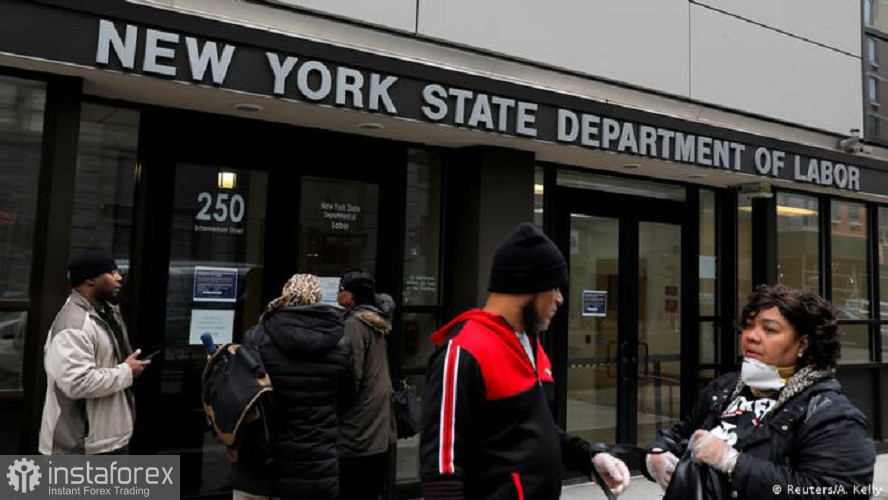The first increase in a month reported by the Labor Department on Thursday did not change economists' expectations for another month of solid employment gains in February.
There is an acute shortage of workers, which has seen employers boosting wages and offering other incentives to retain their workforce as well as attract labor. Economists blamed the rise in claims on week-to-week volatility in the data and harsh weather in some parts of the country.
"Given the regular noise in the data and the range of factors that can impact filings we don't think the recent jump in initial claims filings is particularly worrisome at this point," said Daniel Silver, an economist at JPMorgan in New York. "Overall, we think that the labor market remains tight."
Initial claims for state unemployment benefits increased 23,000 to a seasonally adjusted 248,000 for the week ended February 12. Economists polled by Reuters had forecast 219,000 applications for the latest week.
Unadjusted claims climbed 7,742 to 238,482 last week. There were big increases in filings in Missouri, Ohio and Kentucky, which offset notable declines in Pennsylvania, New Jersey and Wisconsin.
Claims had been declining since hitting a three-month high in mid-January as coronavirus cases, fueled by the Omicron variant, raged across the country. The United States is reporting an average of 145,769 new COVID-19 infections a day, sharply down from the more than 700,000 in mid-January.
There was a near record 10.9 million job openings at the end of December, keeping layoffs very low. Claims have plunged from a record high of 6.149 million in early April 2020.
Last week's data covered the period during which the government surveyed business establishments for the nonfarm payrolls portion of February's employment report. Claims are significantly below their 290,000 level in mid-January.
The economy created 467,000 jobs in January. The labor market is generating strong wage growth, which is contributing to high inflation. Minutes of the Federal Reserve's Jan. 25-26 meeting published on Wednesday showed many officials at the US central bank "viewed labor market conditions as already at or very close to those consistent with maximum employment."
The Fed is expected to start raising interest rates in March to quell inflation, with economists anticipating as much as seven hikes this year.
Underscoring the tightening labor market conditions, the number of people receiving benefits after an initial week of aid dropped 26,000 to 1.593 million in the week ended Feb. 5. A total of 2.064 million people were receiving unemployment checks under all programs at the end of January.
"Allowing for the volatility in these weekly data and the low signal quality that these data have had for projecting payrolls, there are no signs here of a change in labor market trends," said Conrad DeQuadros, senior economic advisor at Brean Capital in New York.
Frosty weather in January led to a drop in housing construction. A separate Commerce Department report released on Thursday showed that housing construction fell 4.1% last month to a seasonally adjusted annual rate of 1.638 million units.
Temperatures were below average from the Midwest and Tennessee Valley to the Northeast in January, according to the National Centers for Environmental Information.
Single-family housing starts, which account for the biggest share of homebuilding, dropped 5.6% to a rate of 1.116 million units last month. Single-family homebuilding fell in the Northeast, Midwest and South, but rose in the West.
In a sign that last month's drop in starts was temporary, permits for future homebuilding rose 0.7% to a rate of 1.899 million units, the highest since May 2006.
Single-family permits surged 6.8% to a rate of 1.205 million units, a one-year high. The supply of previously owned homes on the market is at record lows.
However, builders are facing challenges from soaring prices for inputs. Prices for softwood lumber, which is used for framing, shot up 25.4% in January after a 21.3% rise in December, the Labor Department's producer price report showed this week. The United States last November nearly doubled the duties on imported Canadian softwood lumber after a review of its anti-dumping and countervailing duty orders.
The National Association of Homebuilders said on Wednesday that building material production bottlenecks were raising construction costs and delaying projects. The NAHB noted that "many builders are waiting months to receive cabinets, garage doors, countertops and appliances."
The backlog of houses approved for construction but not yet started surged to a record last month.
Rising mortgage rates could also slow demand for housing, especially among first-time home buyers. According to the Mortgage Bankers Association, the 30-year fixed mortgage rate jumped above 4% last week for the first time since 2019.
"Strong demand, sparse inventory, relatively upbeat homebuilder sentiment and a large backlog of starts – which climbed to a record high in January – should support new home construction this year," said Nancy Vanden Houten, lead US economist at Oxford Economics.
 English
English 
 Русский
Русский Bahasa Indonesia
Bahasa Indonesia Bahasa Malay
Bahasa Malay ไทย
ไทย Español
Español Deutsch
Deutsch Български
Български Français
Français Tiếng Việt
Tiếng Việt 中文
中文 বাংলা
বাংলা हिन्दी
हिन्दी Čeština
Čeština Українська
Українська Română
Română


